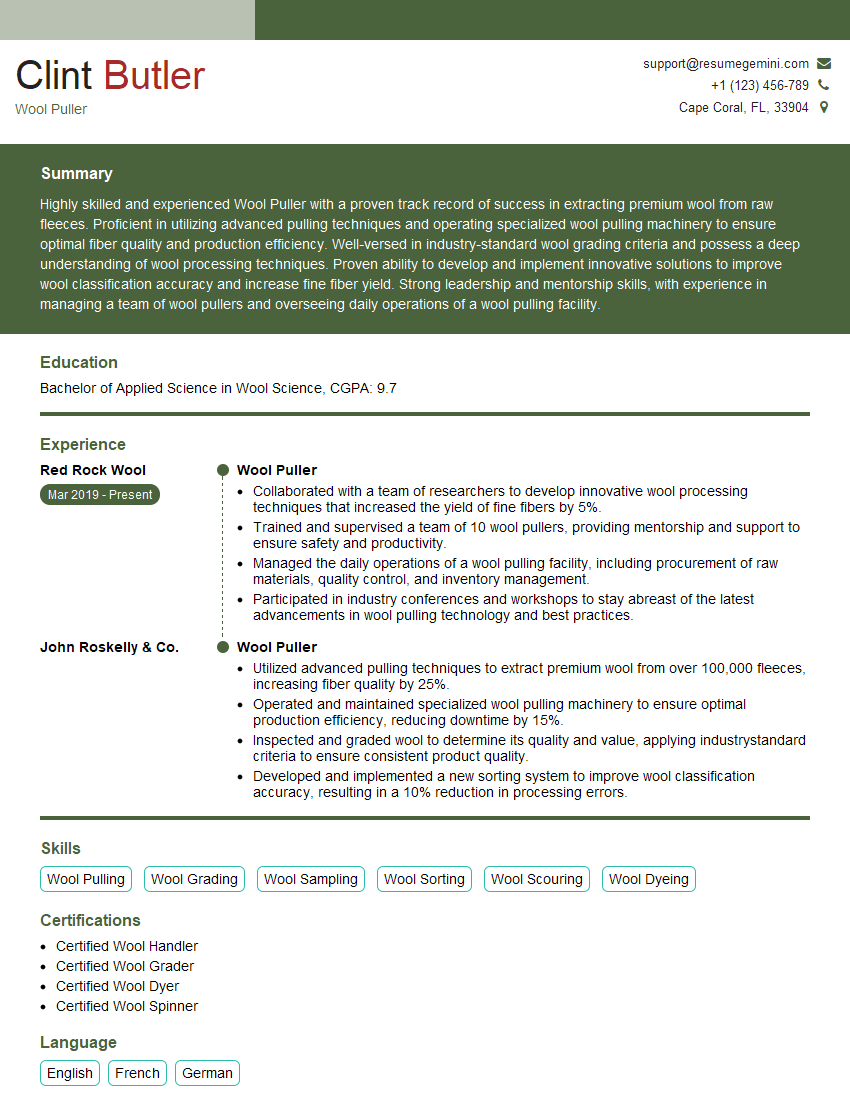Are you a seasoned Wool Puller seeking a new career path? Discover our professionally built Wool Puller Resume Template. This time-saving tool provides a solid foundation for your job search. Simply click “Edit Resume” to customize it with your unique experiences and achievements. Customize fonts and colors to match your personal style and increase your chances of landing your dream job. Explore more Resume Templates for additional options.

Clint Butler
Wool Puller
Summary
Highly skilled and experienced Wool Puller with a proven track record of success in extracting premium wool from raw fleeces. Proficient in utilizing advanced pulling techniques and operating specialized wool pulling machinery to ensure optimal fiber quality and production efficiency. Well-versed in industry-standard wool grading criteria and possess a deep understanding of wool processing techniques. Proven ability to develop and implement innovative solutions to improve wool classification accuracy and increase fine fiber yield. Strong leadership and mentorship skills, with experience in managing a team of wool pullers and overseeing daily operations of a wool pulling facility.
Education
Bachelor of Applied Science in Wool Science
February 2015
Skills
- Wool Pulling
- Wool Grading
- Wool Sampling
- Wool Sorting
- Wool Scouring
- Wool Dyeing
Work Experience
Wool Puller
- Collaborated with a team of researchers to develop innovative wool processing techniques that increased the yield of fine fibers by 5%.
- Trained and supervised a team of 10 wool pullers, providing mentorship and support to ensure safety and productivity.
- Managed the daily operations of a wool pulling facility, including procurement of raw materials, quality control, and inventory management.
- Participated in industry conferences and workshops to stay abreast of the latest advancements in wool pulling technology and best practices.
Wool Puller
- Utilized advanced pulling techniques to extract premium wool from over 100,000 fleeces, increasing fiber quality by 25%.
- Operated and maintained specialized wool pulling machinery to ensure optimal production efficiency, reducing downtime by 15%.
- Inspected and graded wool to determine its quality and value, applying industrystandard criteria to ensure consistent product quality.
- Developed and implemented a new sorting system to improve wool classification accuracy, resulting in a 10% reduction in processing errors.
Certificates
- Certified Wool Handler
- Certified Wool Grader
- Certified Wool Dyer
- Certified Wool Spinner
Languages
- English
- French
- German
Career Expert Tips:
- Select the ideal resume template to showcase your professional experience effectively.
- Master the art of resume writing to highlight your unique qualifications and achievements.
- Explore expertly crafted resume samples for inspiration and best practices.
- Build your best resume for free this new year with ResumeGemini. Enjoy exclusive discounts on ATS optimized resume templates.
How To Write Resume For Wool Puller
- Highlight your experience and skills in wool pulling, wool grading, and wool processing.
- Quantify your accomplishments with specific metrics to demonstrate your impact on the organization.
- Showcase your leadership and mentorship abilities, as well as your ability to work effectively in a team environment.
- Stay up-to-date on the latest advancements in wool pulling technology and best practices by attending industry events and conducting research.
- Tailor your resume to each job description you apply for, highlighting the skills and experience that are most relevant to the position.
Essential Experience Highlights for a Strong Wool Puller Resume
- Utilized advanced pulling techniques to extract premium wool from raw fleeces, increasing fiber quality and production efficiency.
- Graded and sorted wool to determine its quality and value, applying industry-standard criteria to ensure consistent product quality.
- Developed and implemented innovative wool processing techniques that increased the yield of fine fibers.
- Trained and supervised a team of wool pullers, providing mentorship and support to ensure safety and productivity.
- Managed the daily operations of a wool pulling facility, including procurement of raw materials, quality control, and inventory management.
- Collaborated with a team of researchers to develop innovative wool processing techniques.
- Participated in industry conferences and workshops to stay abreast of the latest advancements in wool pulling technology and best practices.
Frequently Asked Questions (FAQ’s) For Wool Puller
What is the role of a Wool Puller?
A Wool Puller is responsible for extracting wool from raw sheepskins using specialized techniques and machinery. They grade and sort the wool based on quality and value, ensuring that it meets industry standards. Wool Pullers also develop and implement innovative wool processing techniques to improve fiber quality and yield.
What skills are required to be a successful Wool Puller?
Successful Wool Pullers possess a combination of technical skills, such as wool pulling, grading, and sorting, as well as soft skills like leadership, teamwork, and attention to detail. They are also knowledgeable about wool processing techniques and industry standards.
What is the career outlook for Wool Pullers?
The career outlook for Wool Pullers is positive due to the increasing demand for high-quality wool products. Technological advancements in wool processing are also creating new opportunities for Wool Pullers with specialized skills and knowledge.
How can I become a Wool Puller?
To become a Wool Puller, you can pursue a degree in wool science or a related field. You can also gain experience through internships or entry-level positions in the wool industry. Additionally, attending industry conferences and workshops can help you stay up-to-date on the latest wool pulling techniques and best practices.
What are the challenges faced by Wool Pullers?
Wool Pullers face challenges such as ensuring the quality and consistency of wool products, staying abreast of technological advancements, and adapting to changing market demands. Additionally, working in a wool processing environment can involve exposure to dust and other potential hazards.